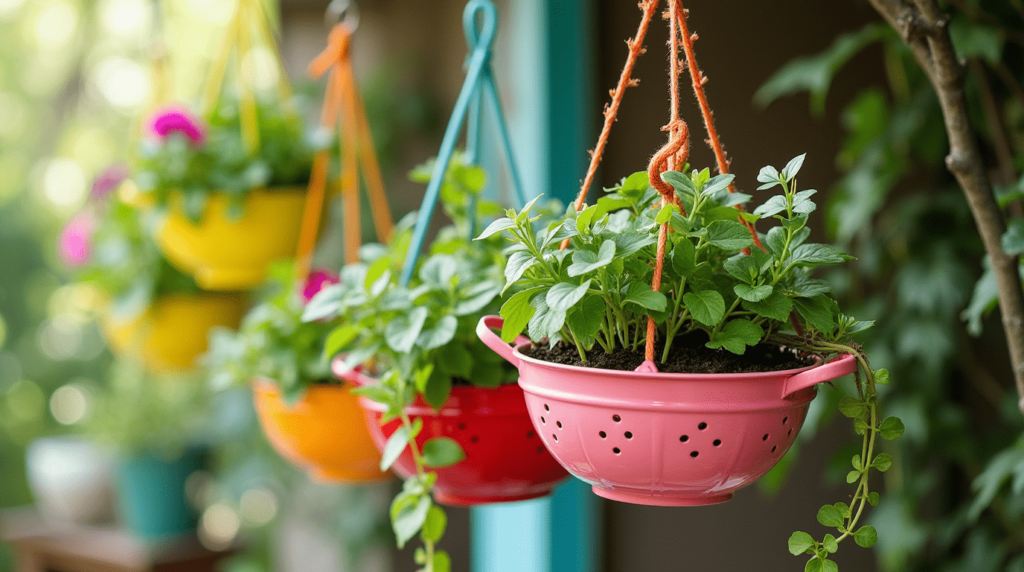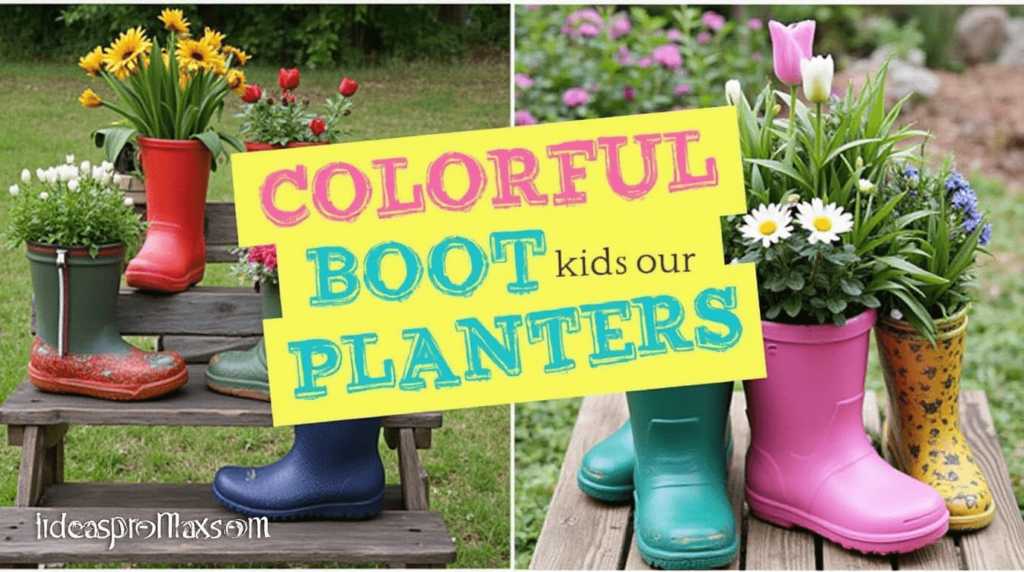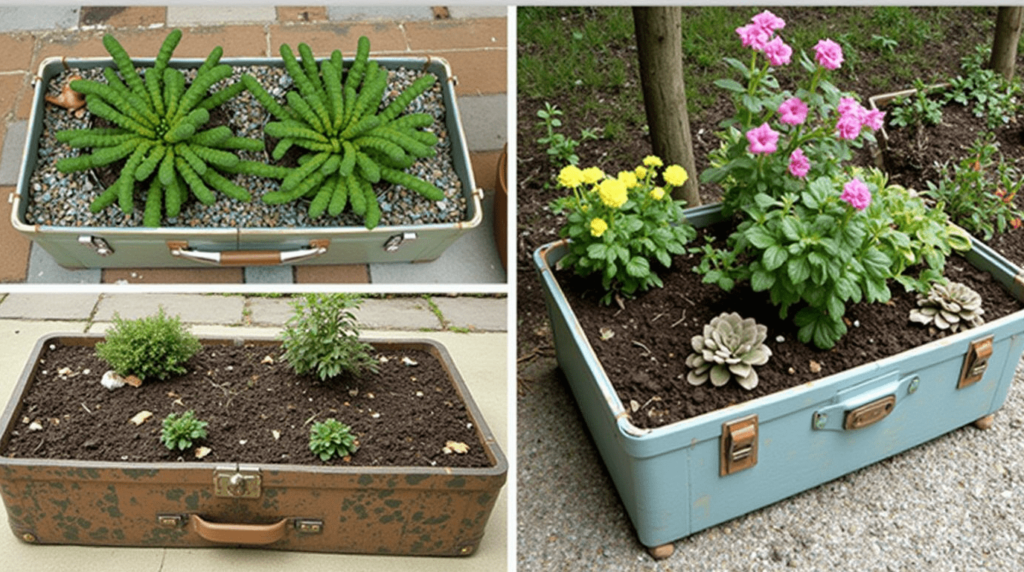Have you ever looked at an old colander and seen its potential beyond straining pasta? With a few simple steps, you can transform colorful colanders into eye-catching hanging planters brimming with cascading flowers and trailing greenery. This creative upcycling project adds whimsical charm to porches, patios, and garden spaces while giving new purpose to kitchen tools that might otherwise be discarded.
Why Colander Hanging Planters Are Trending in Garden Design
Garden enthusiasts are increasingly drawn to repurposed planters, with colander hanging planters standing out as particular favorites for several compelling reasons:
- Built-in drainage: Colanders’ natural drainage holes eliminate the need for drilling or adding gravel layers
- Lightweight design: Metal and plastic colanders are easy to hang without straining supports
- Vintage appeal: Especially when using colorful enamel or retro-patterned colanders
- Perfect size: Typically ideal for showcasing trailing plants without becoming too heavy
According to recent gardening trends, hanging gardens have gained 56% more popularity in the past year, particularly in urban settings where vertical gardening maximizes limited space. Additionally, upcycled planters align with sustainable gardening practices, which have become increasingly important to environmentally-conscious gardeners.
Materials Needed for Your Colander Hanging Planters
Before starting your project, gather these essential supplies:
| Basic Materials | Optional Enhancements | Tools Required |
|---|---|---|
| Colorful colanders | Spray paint for customizing | Scissors or wire cutters |
| Potting soil | Decorative chains | Pliers (for metal work) |
| Selection of trailing plants | Waterproof labels | Measuring tape |
| Hanging chains or ropes | Decorative beads for chains | S-hooks for hanging |
| Coconut coir liner or moss | Plant fertilizer | Gloves for handling soil |
| Hooks for mounting | Weatherproof sealer for metal | Small trowel |
“The most beautiful gardens incorporate unexpected elements that bring personality to the space. Colander hanging planters do this perfectly—they’re functional, whimsical, and tell a story of creative reuse.” – Garden Design Quarterly
Step-by-Step Guide to Creating Colander Hanging Planters
1. Selecting and Preparing Your Colanders
The foundation of your hanging garden begins with choosing the right colanders:
- Metal colanders: Offer vintage charm and durability but may require rust prevention
- Enamel colanders: Provide vibrant color and retro appeal
- Plastic colanders: Lightweight and available in bright colors
- Stainless steel: Modern look that complements contemporary spaces
Before planting, prepare your colanders with these steps:
- Clean thoroughly with mild soap and warm water
- If painting, sand metal surfaces lightly for better adhesion
- Apply rust inhibitor to metal colanders if using outdoors
- For customization, apply outdoor-suitable spray paint in desired colors
- Allow painted surfaces to cure completely (typically 24-48 hours)
Pro tip: If using antique or collectible colanders, consider applying a clear protective coating to preserve any patterns or designs while protecting from weather exposure.
2. Creating Proper Drainage and Lining
While colanders naturally have drainage holes, some preparation ensures optimal plant growth:
Lining Options:
- Coconut coir: Provides excellent moisture retention while allowing drainage
- Sphagnum moss: Natural appearance that helps retain moisture
- Landscape fabric: Thin yet effective for preventing soil loss
- Coffee filters: Budget-friendly option for small colanders
To prepare the interior:
- Cut lining material slightly larger than colander interior
- Press lining material gently against inside walls
- Create small slits in lining to align with larger drainage holes
- For metal colanders, consider adding a plastic liner between metal and soil to prevent corrosion
3. Hanging System Installation
Creating secure hanging mechanisms ensures your colander planters remain safely suspended:
Hanging Methods:
- Three-point chain system: Attaches to equidistant points around colander rim
- Handle attachment: Utilizes existing colander handles if present
- Central hook system: Creates one strong central attachment point
- Macramé style: Wraps decorative cord around colander for bohemian look
For the basic chain method:
- Measure and cut three equal lengths of chain or sturdy cord
- Attach chains to colander rim at equidistant points
- Join chains at top with an S-hook or carabiner
- Test weight capacity before adding soil and plants
Safety tip: Ensure your hanging points can support the weight of the colander, soil, plants, and water (which can be considerable when freshly watered).
4. Plant Selection and Arrangement
Choosing appropriate plants dramatically impacts the visual appeal of your colander planters:
Best Plants for Colander Hanging Planters:
| Plant Type | Varieties | Special Features |
|---|---|---|
| Trailing Flowers | Calibrachoa, Lobelia, Petunias | Cascading blooms |
| Foliage Plants | Pothos, String of Pearls, Vinca Vine | Interesting leaf patterns |
| Herbs | Trailing Thyme, Oregano, Mint | Fragrant and functional |
| Succulents | String of Bananas, Burro’s Tail | Lower water requirements |
For maximum visual impact, consider these planting strategies:
- Thriller-Filler-Spiller method: Upright centerpiece, mid-height fillers, and trailing edge plants
- Monochromatic scheme: Different plants in similar color family
- Complementary colors: Plants with blooms that contrast with colander color
- Single specimen focus: One spectacular trailing plant as the star
For gardeners seeking additional upcycled planting options, tire planters offer excellent complementary features. Paint old tires in bright colors and stack for tiered planters that provide a grounded counterpoint to your suspended colander displays.
Maintenance Tips for Thriving Colander Gardens
Keep your colander hanging planters looking their best with these care practices:
Watering Considerations:
- Check moisture levels more frequently than ground plants
- Water when top inch of soil feels dry
- Consider self-watering adaptations for vacation periods
Seasonal Care:
- Fertilize with diluted liquid fertilizer every 2-3 weeks during growing season
- Trim trailing plants to encourage fullness
- Refresh soil annually or when plants show signs of stress
- Bring metal colanders indoors during harsh winters to prevent damage
Creative Variations to Consider
Customize your colander hanging planters with these inspiring ideas:
- Theme gardens: Create herb-specific or color-themed collections
- Graduated displays: Hang multiple sizes at varying heights
- Indoor adaptation: Use decorative colanders for houseplant displays
- Seasonal rotation: Switch out plants for seasonal color and interest
Creating colander hanging planters transforms ordinary kitchen items into charming garden features that add personality and vertical interest to your outdoor spaces. This accessible upcycling project requires minimal investment while yielding beautiful results that showcase your creativity and environmental consciousness.
Have you created hanging planters from repurposed items? Share your projects in the comments below! For more upcycling inspiration, check out our guides on creating ladder plant stands or transforming old kitchenware into unique garden features.


